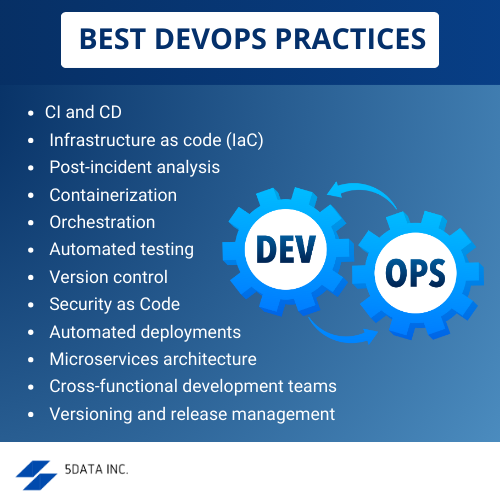What we cover in this blog
Key Takeaways
- DevOps integrates development and operations teams and yields high-quality applications.
- Significant role of DevOps decoded.
- Best Practices of DevOps develop successful end products.
- Businesses benefit in discrete ways through DevOps best practices.
Significance Of DevOps
DevOps represents a powerful methodology that seamlessly integrates software development and operations with continuous integration and delivery, resulting in improved software delivery and continuous deployment. This approach fosters collaboration and harnesses advanced automated tools to accelerate product delivery, enhance system reliability, and maintain business agility and competitiveness.
DevOps delivers concrete financial benefits through:
Communication
By facilitating communication and fostering collaboration around shared goals, a successful DevOps culture leads to more efficient operations and substantial cost savings. This efficiency and cost-effectiveness should instill confidence and security in business decision-makers.
Automation
Implementing automation to streamline repetitive tasks and allocate resources for innovative projects, significantly reducing manual errors and operational costs while enhancing scalability and reliability in software delivery.
Agility
Promoting agility, enabling more efficient, iterative development processes and frequent software releases with fewer failures, ultimately accelerating time-to-market for new features and products.
DevOps goes beyond merging development and operations roles. It creates a collaborative environment where both disciplines empathize with each other’s challenges and work together effectively, making you an integral part of its operations teams and the business’s success in the process.
Best DevOps Practices
The adoption of DevOps has become widespread among software developers, reflecting its increasingly integral role in cloud-based software engineering and decisions. DevOps engineers need to recognize the financial implications of their choices and collaborate with finance, leadership, and business teams to maximize the business value derived from their cloud deployments.
Listed below are DevOps best practices that help to streamline the development and operations processes for teams.
1. CI and CD
Continuous Integration (CI) brings together code changes and identifies errors early through various automation tools. Continuous Delivery (CD) swiftly deploys validated code, accelerating market releases. Together, they facilitate seamless transitions and alleviate deployment bottlenecks. This systematic approach results in significant cost savings and enhanced efficiency.
2. Infrastructure as Code (IaC)
Infrastructure as Code (IaC) transforms infrastructure configuration management into software code, providing operational and cost benefits. It streamlines infrastructure provisioning, reduces human errors, and enables version control seamlessly between infrastructure configurations and integrating with existing CI/CD pipelines for accelerated deployment. Operations teams perform these tasks with the assistance of application development services.
3. Post-incident analysis
Every incident offers a chance to learn and enhance processes. By thoroughly analyzing the root causes, we can identify areas for growth. Proactively addressing these issues will minimize future disruptions and financial impact.
The DevOps methodology is centered on risk mitigation and continuous improvement throughout. Through comprehensive post-incident assessments and ongoing feedback, DevOps tools establish visibility and foster a culture that embraces challenges as opportunities for development. This approach reinforces system resilience and supports long-term financial effectiveness and business success.
4. Containerization
Containerization is now a widely adopted tool in the DevOps pipeline, providing an effective way to break down large workloads, workflows, and code blocks.
- Uniformity: Containerization effectively encapsulates applications and their dependencies within isolated containers, guaranteeing a uniform deployment experience across diverse production environments.
- Efficiency: Containers share the host system’s OS while maintaining isolation, allowing businesses to run multiple applications on the same hardware and optimize infrastructure investments.
- Scalability: Containers enable dynamic scaling to accommodate changing traffic and application needs, ensuring cost-effective and efficient resource utilization.
5. Orchestration
Orchestration tools like Kubernetes ensure seamless deployment and scaling of containers. Kubernetes excels in configuration management tools, reducing downtime, adapting to demand, and introducing phased updates. It allocates resources based on actual demands for optimal application performance, leading to substantial cost savings for organizations.

5. Orchestration
Orchestration tools like Kubernetes ensure seamless deployment and scaling of containers. Kubernetes excels in configuration management tools, reducing downtime, adapting to demand, and introducing phased updates. It allocates resources based on actual demands for optimal application performance, leading to substantial cost savings for organizations.
6. Automated testing
Automated performance testing enhances observability, expedites time-to-market, and upholds deployment quality, all while optimizing costs.
Some of the benefits of automated testing include:
a. Ensuring code quality
Implementing thorough tests for each code modification minimizes the occurrence of bugs in the production environment. Early detection and continuous monitoring for feedback help prevent costly errors and safeguard against downstream consequences.
b. Accelerating the development cycle
Manual unit tests are thorough but slow, often causing delays in the software development life cycle (SDLC). Automated testing provides quick and consistent code verification, eliminating manual test repetition and allowing development teams to focus on proactive strategies to streamline the software development lifecycle.
c. Preventing costly production issues:
Automated performance testing ensures code undergoes strict examination before production, preventing application disruptions that can lead to revenue losses, increased costs, or harm to the brand.
7. Version control
Version control prevents conflicts by logging code changes and flagging overlapping modifications. It also defends against reworking errors, provides seamless code access, and fosters better team communication.
8. Security as Code
This methodology emphasizes embedding security principles, metrics, and checks into the software development pipeline to foster observability. Benefits of this methodology include:
- Early intervention:
Code is consistently evaluated for threats as it’s developed, allowing DevOps teams to spot and address potential vulnerabilities early, minimizing the risk of costly breaches later. - Merging security and FinOps:
Security as code integrates seamlessly with FinOps principles, emphasizing cost transparency and optimization to help businesses avoid high costs related to data breaches or regulatory fines. - Financial control:Automating security processes results in predictable expenditures and enables smarter budgeting and resource allocation, safeguarding assets and supporting the FinOps objective of maximizing business value at minimal cost.
9. Automated deployments
Automating the deployment process reduces errors, ensures consistency, and speeds up release cycles. Linter tools analyze code for errors and coding standards violations without executing the code, making them essential for early code review. Automated deployments developed by software application development companies transform manual tasks into rapid actions.
10. Microservices architecture
The microservices architecture is vital for modern application design. It enables scalable, cost-efficient, and independent deployment of individual services written in different languages or frameworks. It also prevents single points of failure and ensures that updates or fixes to specific services maintain the integrity of the entire application.
11. Cross-functional development teams
Diverse skill sets in DevOps teams lead to innovative problem-solving. Cross-functional teams optimize resource allocation, resulting in lower overheads, agile project management, efficient development process, faster market entry, and improved product quality. Joint decision-making considers a wider range of factors, producing more comprehensive outcomes.
12. Versioning and release management
Versioning provides unique identifiers for different stages of the software delivery process, allowing DevOps teams to revert to stable states if issues arise. Release management coordinates the introduction of updates, ensuring informed and continuous feedback and optimized deployment strategies.
Benefits Of Implementing DevOps Best Practices
DevOps processes and tools are crucial in streamlining software development processes and enabling their continuous integration and deployment in digital transformation projects. Consider the following seven benefits:
- Quicker development cycles
- Improved communication
- Enhanced system reliability
- More efficient resource utilization
- Better risk management
- Auditable code changes and history
- Cross-system integration
Top application development companies possess the expertise to help firms leverage DevOps to attain such benefits.
Conclusion
The future of DevOps is extremely promising, with an increasing number of organizations acknowledging the significant value and benefits it brings to their overall operations teams and software development process. As technology continues to advance, making businesses dependent on digital solutions, the demand for efficient and streamlined development practices will undoubtedly continue to grow.
Frequently Asked Questions (FAQs)
1. What is DevOps?
DevOps represents a software engineering practice and cultural mindset that brings together software development and operational teams to ensure continuous and efficient product deliveries.
2. What are the benefits of leveraging DevOps?
DevOps practices empower teams to swiftly and effectively deliver products with shortened development cycles, heightened deployment frequency, and enhanced release reliability, all in alignment with business objectives.
3. What are some DevOps practices that demonstrate agile principles?
The future of DevOps holds great promise, as an increasing number of organizations are realizing the substantial value and benefits it brings to their overall software development process. With technology advancing and businesses relying more on digital solutions, there is an undeniable and growing demand for efficient and streamlined development practices.
4. How can DevOps be used to improve collaboration between development and operations teams?
DevOps encourages cross-functional training for team members. The functional training involves developers gaining knowledge about operations infrastructure and deployment practices while operations teams learn about software development tools, code-sourcing methods, and agile methodologies.

